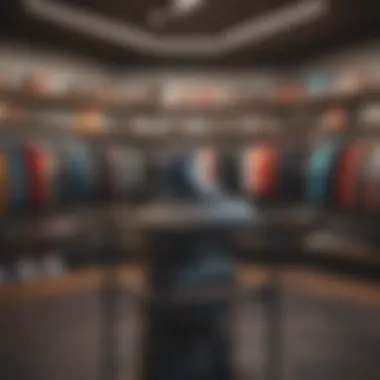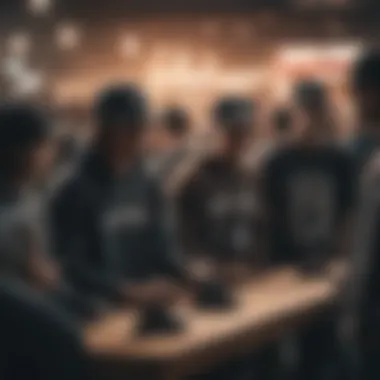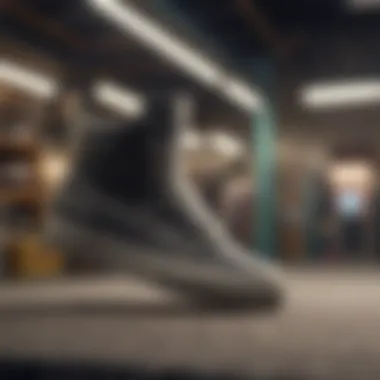Discovering Streetwear: Top Spots to Shop


Intro
In the ever-evolving world of fashion, few styles have captured the essence of youth culture quite like streetwear. This unique blend of casual wear, sports influence, and urban aesthetics is more than just clothing; it's a lifestyle and a statement. In today's bustling urban environments, streetwear clothing isn't just confined to high-end boutiques or online retailers. Instead, it thrives in various venues that reflect the locality and creativity of its wearers.
Streetwear enthusiasts find themselves on a constant quest for the latest drops, signature brands, and those rare finds. From a cozy corner shop with hand-painted murals to popular online platforms that connect buyers globally, each venue offers a unique experience and product range. Understanding where to look and what to expect can greatly enhance that experience. This article aims to guide you through the vibrant landscape of streetwear, highlighting various hubs where you can discover the latest and the greatest in this dynamic fashion realm.
Understanding Streetwear
Grasping the essence of streetwear is crucial, not just for avid fashion enthusiasts, but also for those intricately woven into the fabric of urban culture. This section sheds light on the vital elements of streetwear, examining what truly sets it apart while bringing to the forefront its enduring influence on contemporary fashion. Understanding streetwear involves more than just recognizing trends; it requires an appreciation of its origins, cultural significance, and the lifestyles it encapsulates.
Defining Streetwear Culture
At its heart, streetwear is a bold statement—a blend of art, music, and fashion that emerged from the streets. Rooted deeply in the DIY ethos and grassroots movements, it serves as a canvas for self-expression. Streetwear isn’t merely about clothing; it’s about lifestyle and attitude. The culture represents the voice of the urban youth, often influenced by skateboarding, hip-hop, and graffiti. From oversized hoodies to graphic tees, the designs reflect both an aesthetic and a countercultural stance.
In the realm of streetwear, brands like Supreme and Off-White have become synonymous with this grassroots art form,
shaping perceptions and interactions in the fashion landscape.
Streetwear also plays a psychological role for many. It provides a sense of belonging and community for individuals who often feel isolated in mainstream fashion narratives. As these communities thrive, they create spaces for dialogue and creativity, encouraging collaborations that push boundaries.
Despite its often informal nature, the streetwear scene carries a certain level of exclusivity. Limited releases and drops can lead to a sense of urgency and obsession, making every piece not merely clothing, but a collectible item steeped in social meaning.
With that being said, streetwear is dynamic, often shifting with the political and social climate, showcasing its ability to be a reactive force in fashion culture.
The Evolution of Streetwear Fashion
Streetwear's evolution is a tale worth unpacking. What started as a niche segment has transformed into a juggernaut, integrating with high fashion and becoming a commercial powerhouse. In the late 80s and early 90s, labels like Stüssy and A Bathing Ape began to carve paths that would change the fashion landscape forever.
These brands sponsored skateboarders and musicians, creating an unrivaled sense of authenticity that resonated with consumers. A pivotal moment came with the collaboration between brands and high-end fashion houses. When Raf Simons and Gucci embraced streetwear aesthetics, it validated the genre as serious fashion. Kim Jones even infused streetwear elements into his role at Dior, further threading the lines between high fashion and street sensibility.
Today, streetwear often features aspirational elements, reflecting not just style, but also values like sustainability and inclusivity. Many brands are turning towards eco-friendly materials and ethical production practices, acknowledging the responsibility that comes with their influence.
However, one should be cautious—while the mainstream adoption has allowed for wider access to streetwear, it also runs the risk of diluting the culture, potentially transforming it into mere fashion without soul.
Streetwear continues to challenge the norms, ensuring that it stays relevant in a world of fast fashion, grabbing hold of the sentiments of the youth and maintaining its pulse on the societal shifts.
"Streetwear is a culture, not just clothes. It’s about what we believe in and how we express it through our style."
By examining these facets, readers gain insight into the intricate layers that define this vibrant culture, preparing them for the exploration of where to find these trends in urban landscapes.
Mainstream Retailers
Mainstream retailers form a significant backbone in streetwear distribution, offering a balance between accessibility and brand representation. These outlets allow streetwear to reach a wider audience, making it possible for anyone with an interest to tap into the vibrant culture surrounding this style. From those who are just dipping their toes into the scene to die-hard enthusiasts, mainstream retailers provide a valuable entry point.
One of the primary advantages of shopping at mainstream retailers is the ease of access. They often have numerous branches in busy urban areas, making it convenient for shoppers to browse the latest trends without having to hunt through obscure boutiques. Furthermore, many of these retailers maintain extensive online stores, which cater to a tech-savvy generation. This online functionality can streamline the buying process, allowing customers to snag sought-after items without needing to leave their couch.
However, while mainstream options offer a range of benefits, it's essential to note that they often lack the exclusivity that characterizes streetwear culture. Limited-edition pieces or unique collaborations may not always make their way into these big-name shops. When shopping mainstream, some fans might feel they're missing out on the richer, more individualistic side of streetwear—a space often claimed by niche boutiques and independent designers.
Iconic Brands and Their Offerings
At the heart of mainstream streetwear retailers are the iconic brands that have helped sculpt the landscape over the years. Brands like Nike, Adidas, and Supreme are more than just labels; they embody a lifestyle and culture that resonates strongly within the streetwear community.
- Nike carries several streetwear lines and collaborations, often featuring bold graphics and cutting-edge designs.
- Adidas, through its partnership with designers and celebrities, continually redefines athleisure, making it a favorite among urban dwellers.
- Supreme has earned nearly cult-like status, with its limited runs creating an air of exclusivity that resonates particularly well with youth culture.
These brands often launch seasonal collections, ensuring that the offerings are refreshed regularly. This continuous evolution keeps fans engaged, eagerly anticipating each new drop.
Big-Box Stores with Streetwear Sections
Surprisingly, big-box stores have entered the fray by allocating sections specifically for streetwear. Think of stores like Target or Walmart, which have started to recognize the demand for urban styles and have broadened their clothing selections to include more street-friendly options. This isn't just a passing trend; it highlights a change in consumer preferences.
- These stores often feature partnerships with popular brands, allowing everyday shoppers access to trendy apparel without breaking the bank.
- Furthermore, these stores present an opportunity to discover more affordable alternatives that retain the essence of streetwear without the accompanying price tag.
Despite the benefits, it’s worth considering variability in quality and style. While it's easier on the wallet, the pieces may sometimes lack the unique vibe and craftsmanship of those found in boutique shops.
In summary, mainstream retailers stand as a critical player in the streetwear ecosystem. They offer an entryway into the culture while striking a balance between accessibility and brand identity. With a mix of timeless iconography and newer templates, shopping these outlets can yield advantageous results, whether you’re just starting out or looking to make your mark in the streetwear realm.
Boutiques and Specialty Stores


Boutiques and specialty stores hold a unique position within the landscape of streetwear clothing. This is not just about purchasing a piece of clothing; it's about diving deep into the culture and community that surrounds it. Unlike mainstream retailers that often prioritize volume, boutiques tend to offer carefully curated selections that reflect deep understanding of streetwear’s trends and undercurrents. These shops often serve as microcosms of urban street culture, providing a platform for local artists and designers.
Moreover, shopping at boutique stores allows enthusiasts to discover more than just ordinary fashion; it offers a chance to find items that tell a story, items that might just set the tone for a new trend. One significant benefit of these stores is the personalized shopping experience they provide. Store owners often cultivate relationships with customers, sharing insights and recommendations based on their unique needs and preferences.
Local Boutique Highlights
When exploring local boutiques, each one offers its own twist, adding flavor to the streetwear scene. For example, a shop like Bodega in Boston blends streetwear with lifestyle products, creating a space that feels both curated and welcoming. Their attention to limited releases makes every visit a treasure hunt for unique items.
Similarly, Stussy and Supreme, although they have become larger retail names, began as small, local shops. They emphasize community, often hosting events that draw people into the culture surrounding their brands. Local boutiques can often be the first to spotlight budding brands that may not have yet hit the mainstream radar.
In addition, visiting these stores often gives an added benefit of discovering collaborations and exclusives that aren’t found elsewhere. Beyond just apparel, many boutiques also offer accessories that complete the streetwear aesthetic.
"Shopping at local boutiques is not just buying clothes; it's buying into a culture, a lifestyle, and often a community."
Emerging Designers and Offerings
As the streetwear scene evolves, emerging designers are at the forefront, pushing boundaries and redefining style. These talents often come from diverse backgrounds, infusing their unique perspectives into their collections. Boutiques are crucial spaces for these new voices, providing them with a platform to showcase their work.
Consider Fear of God and Ader Error, which started as niche offerings in smaller settings before gaining widespread acclaim. Emerging designers often lean towards sustainable practices, using organic materials and ethical production methods to create standout pieces that also take a stance on social issues.
Another noteworthy aspect is the often limited number of pieces available—the scarcity drives demand and maintains exclusivity, which is a big allure in streetwear. Customers frequently find themselves purchasing not just for fashion, but for the chance to own a piece of creativity.
Online Shopping Platforms
In today’s fast-paced world, online shopping platforms have reshaped how streetwear aficionados seek and acquire their favorite pieces. With a few taps on a smartphone, one can access a trove of styles from the comfort of their own home. This convenience is a major draw. Not only does it offer a vast selection, but these platforms often present items that might not be easily found in local shops. However, it’s important to know the landscape; while the variety is alluring, so are the potential pitfalls.
Popular E-Commerce Sites
For anyone in the hunt for streetwear, popular e-commerce sites like ASOS, Zalando, and Amazon often rank at the top of the list. Here’s why these platforms are particularly favored:
- Extensive Selection: They offer everything from mainstream to rare items, allowing shoppers to explore different styles and brands all in one place.
- Price Comparisons: Users can quickly discern which sites offer the best deals. This is particularly useful when budgeting for that coveted Supreme hoodie or those new Nike sneakers.
- User Reviews: Shoppers benefit from community feedback. Insight into fit, quality, and authenticity helps inform smarter buying decisions.
When you shop on these platforms, though, it is wise to keep a keen eye on product details and return policies. Sometimes, good photos can mislead, and you might end up with something that looks great on-screen but doesn't quite meet your expectations upon delivery.
Niche Marketplaces for Unique Finds
Beyond the big names, niche marketplaces like Grailed and Depop cater specifically to streetwear enthusiasts, connecting sellers directly to buyers in innovative ways. What sets these platforms apart is their focus on the community and unique offerings:
- Rare Collections: Niche sites often showcase hard-to-find pieces, making them a go-to for collectors eager to expand their wardrobe with one-of-a-kind items.
- Authenticity Checks: Many niche sites have measures in place to ensure that what you're getting is legit. This gives buyers peace of mind when investing in high-value items.
- Sustainable Options: Platforms like Poshmark promote second-hand shopping, aligning with a growing movement toward sustainability without sacrificing style.
As a streetwear enthusiast, exploring these avenues can yield results beyond what traditional retailers might offer. Yet, exercise caution; verify seller reputations, read descriptions thoroughly, and don’t be shy about asking questions to avoid regrettable purchases.
"Online shopping transforms the hunt for that perfect streetwear piece into an adventure, but it pays to tread carefully."
In essence, online shopping platforms provide a dynamic and diverse environment for those looking to elevate their streetwear game. By discerning the landscape, enthusiasts have the distinct opportunity to express their unique style while staying ahead of the trends.
Thrift and Vintage Stores
Thrift and vintage stores are essential components of the streetwear ecosystem. They provide an interesting intersection where budget-conscious shoppers meet the world of unique fashion, often full of character and history. Each find in these stores can turn into a statement piece, capturing a vibe that mainstream outlets struggle to replicate. This section will delve into the benefits and considerations of shopping in these often-overlooked havens of style.
Finding Hidden Gems
When you step into a thrift shop, it’s more than just a shopping trip; it’s an adventure. The thrill of rummaging through racks can lead to striking gold. Oftentimes, you stumble upon an obscure band tee or a vintage jacket that tells a story. To increase your chances of finding these hidden gems, a few strategies can be handy:
- Frequent Visits: The inventory changes constantly in thrift stores. New pieces roll in nearly daily, making it worth visiting frequently.
- Dig Deep: Take your time to sift through items. Sometimes the best pieces are buried underneath less exciting options.
- Know Your Brands: Familiarize yourself with lesser-known brands that have established a reputation among streetwear enthusiasts. Vintage racing jackets or high-quality denim often come from these names.


Thrift stores also attract other individuals with an eye for fashion, so engaging with fellow shoppers can lead to valuable information about where to find the best pieces in your area.
The Sustainability Factor
In today's world, making conscious choices isn't just a trend; it’s becoming a necessity. Thrift and vintage shopping plays an integral role in promoting sustainability within the fashion industry. Rather than contributing to fast fashion, which often ends up in landfills, buying second-hand allows you to reduce your ecological footprint. The following points highlight the importance of sustainability via thrift shopping:
- Conserving Resources: Producing new clothing consumes vast quantities of water, energy, and raw materials. Purchasing second-hand means these resources stay intact.
- Extending Garment Life: Thrift shopping can literally breathe new life into clothing that might otherwise be discarded. Wearing vintage can be not just unique but also a statement against wastefulness.
- Supporting Local Communities: Many thrift stores are community-focused, using proceeds to fund local initiatives.
In summary, choosing thrift and vintage stores goes beyond aesthetics; it reflects a lifestyle choice. For those who skate, surf, or live on the edge, pairing culture with intention creates a fashion statement that resonates deeply with personal identity.
"Streetwear isn’t just what you wear; it’s a reflection of who you are and what you value."
As such, embracing these shops aligns seamlessly with both style and ethics, magnifying the appeal for streetwear enthusiasts.
Events and Pop-Up Shops
Pop-up shops and events have become cornerstones in the vibrant realm of streetwear. They serve not just as channels for selling clothing, but also as cultural hubs that foster community engagement. When you step into a pop-up, it’s often more than just an experience; it’s an event designed to entertain and inspire. Here’s a closer look at why these gatherings hold such significance.
One of the major benefits of attending streetwear festivals or local pop-ups is the opportunity to encounter exclusive merchandise. Many brands choose these venues as platforms to launch limited edition items, ensuring their attendees leave with something that can’t easily be found elsewhere. This is a significant allure, especially for collectors or enthusiasts who want to showcase unique pieces in their wardrobe.
In addition, these events facilitate direct interactions between consumers and brands. You might find yourself chatting with the designers, making it much more personal than browsing online. There's something to be said about that immediacy, where one can feel the fabric, try things on, and even snag information about the creative process behind the clothing. Furthermore, engaging in discussions at pop-up shops can lead to a deeper understanding of brand missions, their ethical practices, and design philosophies.
Lastly, community is key in the streetwear culture, and these events amplify that spirit. Be it skateboarding demonstrations, art showcases, or live DJ sets, these gatherings are alive with energy. They bring together like-minded individuals, creating a dynamic environment where ideas flow, friendships form, and cultural appreciation flourishes.
"Pop-up shops are not just retail spaces; they’re festivals of culture, fashion, and community."
Streetwear Festivals
Streetwear festivals take the concept of pop-up shops to a whole new level. These intricate affairs often span multiple days and showcase a mix of fashion, music, art, and lifestyle. Renowned festivals such as ComplexCon draw crowds from all over, featuring a myriad of brands that highlight the diversity of the streetwear scene.
Attendees can expect to find everything from panel discussions led by industry leaders to exclusive merchandise that disappears faster than you can blink. The blend of brands, both established and emerging, creates a unique atmosphere where innovation and creativity live. Often, these festivals will feature limited-run items that can only be purchased on-site, adding an element of urgency to the experience.
Local Market Scene
On the other hand, local market scenes offer a different flavor. Here, you're likely to stumble upon up-and-coming designers selling their works right alongside vintage shops. The charm of local markets lies in their community-driven approach. There’s a sense of authenticity, where every piece has a story, often woven into the fabric by local artisans or creators.
Shopping in these environments not only supports local economies but also embodies the grassroots spirit of streetwear. Many local markets host regular streetwear events or collaborate with artists for their releases, turning the ordinary shopping trip into a mini-festival of creativity and collaboration.
In summary, events and pop-up shops represent an exciting frontier in streetwear culture. They provide environments rich with opportunities to connect, explore, and discover all while encapsulating the essence of streetwear—innovation, uniqueness, and community.
Collaborative Collections
In the ever-evolving world of streetwear, collaborative collections have carved out a significant niche. These collaborations between established brands and creatives often result in fresh perspectives, unlocking a realm of innovation that can set fashion trends. Essentially, they bring together unique visions, merging style and culture, which creates something truly special for the consumer.
Brand Collaborations to Watch
When considering brand collaborations, a few stand out due to their cultural impact and creativity. Nike and Off-White, for instance, did not just create sneakers; they sparked a cultural dialogue about fashion and art, effectively repositioning sportswear in high fashion. Another notable collaboration is Adidas and Kanye West, which has become iconic, showcasing not only style but also a lifestyle statement that resonates with the masses.
The reasons to keep an eye on such brand partnerships include:
- Cultural Relevance: These collaborations often reflect current social and cultural movements, resonating deeply with consumers.
- Quality and Craftsmanship: Collaborations typically uphold or elevate quality, offering a product that stands the test of time.
- Limited Availability: Many collaborative pieces are produced in limited quantities, ensuring exclusivity and increased demand.
Limited Edition Drops
Limited edition drops underscore the excitement in the streetwear community. Such releases create buzz, as they are often accompanied by intricate marketing strategies that involve teasers and countdowns. The anticipation builds to a frenzy, with fans marking calendars and refreshing web pages to snag their desired item.


Here are some key characteristics of limited edition drops:
- Scarcity: The magic of these drops lies in their limited nature. A drop of 1000 units can create a cult-like following, leading to resale values skyrocketing.
- Innovative Designs: These collections usually showcase design experimentation, pushing boundaries that mass production may not allow.
- Community Engagement: Many brands leverage social media for these drops, allowing fans to be part of the experience. This builds loyalty and a sense of belonging among consumers.
"Limited edition collaborations not only provide unique styles but also foster a deeper connection with the streetwear community."
Streetwear and Skate Culture
Streetwear and skate culture form a dynamic duo that has influenced the realms of fashion and lifestyle, capturing the essence of urban life in ways that resonate with both the youth and seasoned skateboarders. This interconnectedness enriches the narrative of streetwear clothing, demonstrating how the skateboarding community has played a significant role in shaping and evolving streetwear trends. Through the lenses of style, utility, and identity, we can see how these two worlds collide and create a meaningful impact on contemporary fashion.
The Interplay Between Skateboarding and Fashion
To understand the synergy between skateboarding and fashion, one must first appreciate how skate culture emerged from the streets. The roots trace back to the 1970s in California, where skateboarders began to carve out their own identity separate from mainstream fashion. They adopted practical, durable clothing suited for their lifestyle and activities—think baggy pants, oversized tees, and classic sneakers.
This aesthetic gave birth to brands like Vans and Converse, which became synonymous with skate culture. The union between comfort and functionality didn’t just serve skateboarding; it resonated with a broader audience, paving the way for the mainstream acceptance of streetwear. Skateboarding was not only about performance; it was also about how one presented themselves on the street. The idea of standing out while seeking solid, durable clothing became vital.
Moreover, collaborations have surged between established fashion houses and skate brands, showcasing the crossover appeal. The iconic Nike SB line is a prime example, where the brand tailored its performance skate shoes to the latest street style trends.
Representing Identity Through Style
Skate culture thrives on individuality. For many, choosing their streetwear isn’t merely a fashion statement; it is an extension of their identity. One can spot subtle nuances in how different skateboarders style their outfits—whether it’s through the type of skateboard they ride or the brands they sport. Streetwear has become a canvas for expression, bearing witness to personal stories and urban narratives.
Through graphics, colors, and cuts, streetwear can signify belonging to a particular skate scene or lifestyle, communicating affiliations without saying a word. For instance, a simple hoodie adorned with a local skate shop's logo can invoke a sense of community pride. Likewise, a vintage T-shirt featuring a legendary skateboarder might evoke nostalgia among fellow enthusiasts.
"Through style, skateboarders share not just their hobbies but also their identities, making streetwear a vital part of the skateboarding experience."
This identity representation is also evident in skate brands’ marketing efforts, which often feature real skaters rather than models. This authenticity resonates deeply, creating a bond that goes beyond mere consumerism, enriching the community experience and validating individual journeys.
Caring for Your Streetwear
Caring for your streetwear merits consideration far beyond the mere aesthetics of clothing. In this realm of fashion, garments often represent personal expression, culture, and even community identity. For skateboarders and extreme sports athletes, the right clothing isn’t just about style; it’s about functionality, durability, and, most importantly, maintenance. When you invest in quality streetwear, you're not just buying clothes—you're investing in assets that reflect your lifestyle.
Maintenance Tips for Longevity
To ensure that your favorite pieces last longer through the wear and tear of everyday life, here are several tips that resonate well with both casual wearers and hardcore enthusiasts:
- Washing
- Drying
- Storing
- Spot Cleaning
- Always wash your streetwear in cold water. This not only helps to maintain the fabric but reduces fading. Also, it’s wise to turn them inside out before tossing them in the wash. This little trick can save your designs from getting scuffed up.
- Avoid the tumble dryer when possible. It tends to shrink clothes and messes with their structure. Instead, hang your gear up to dry; this not only prolongs their lifespan but also retains the original fit.
- Storage plays a critical role in garment care. Keep your streetwear in a cool, dry place, preferably folded neatly. Hanging them can lead to stretched out fabric on the shoulders, which is something you’d want to avoid.
- For those stubborn stains, spot cleaning can be a lifesaver. Use a mild detergent with a cloth and dab gently—be careful not to rub too hard, as it can damage the fabric.
"Taking good care of your streetwear isn’t just a chore; it’s an art that pays off with every wear."
Styling Your Streetwear Effectively
Styling your streetwear can be quite the creative adventure. Given the rich backgrounds from which streetwear comes, there's a unique opportunity to showcase your personality through your attire. Here are some pointers for achieving that coveted look that turns heads:
- Mix Layers
- Footwear Matters
- Color Coordination
- Personal Touches
- Layering is a streetwear staple. Pairing a graphic tee with an oversized jacket or a flannel can create a relaxed yet stylish vibe. Accessories like beanies or bucket hats complement this style well.
- The right shoes make or break the outfit. Skate shoes, high-tops, or chunky sneakers can add an edgy touch. Avoid mismatched styles; the footwear should harmonize with your overall aesthetic.
- Playing with colors is a time-honored strategy in streetwear. A bold color pop in an otherwise muted palette can create a striking visual effect. Don’t shy away from experimenting; trial and error can lead to great findings.
- Whether it’s pins on your jacket or custom patches, personalizing your streetwear can set you apart in a crowd. These accents can tell a story or reflect a piece of who you are.







